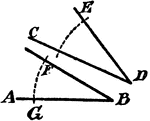
Construction Of An Equal Angle
An illustration showing the construction used to erect an equal angle. "With D as a center, draw the…
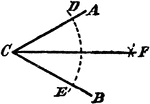
Construction Of A Divided Angle
An illustration showing the construction used to divide an angle into two equal parts. "With C as a…
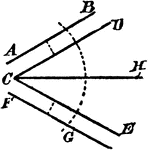
Construction Of A Divided Angle
An illustration showing the construction used to divide an angle into two equal parts when the lines…
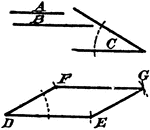
Construction Of A Parallelogram
An illustration showing the construction used to erect a parallelogram given two sides and an angle.…
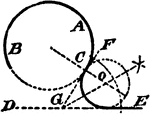
Construction Of A Center And Radius Of A Circle That Will Tangent A Given Circle
An illustration showing how to construct the center and radius of a circle that will tangent a given…
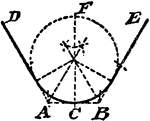
Construction Of A Circle That Tangents 2 Given Lines And Goes Through A Given Point
An illustration showing how to construct a circle that tangents two given lines and goes through a given…
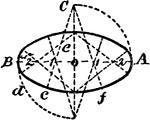
Construction Of An Isometric Ellipse
An illustration showing how to construct an isometric ellipse by compass and six circle arcs. "Divide…
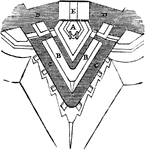
Ravelin
A detached triangular work in fortification, with two embankments which form a projecting angle. In…

Redans
In field fortification, the simplest kind of work employed, consisting of two parapets of earth raised…
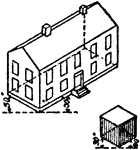
Construction Using Isometric Perspective
An illustration showing how to use isometric perspective. "This kind of perspective admits of scale…

Construction Of An Ellipse Tangent To Two Parallel Lines
An illustration showing how to construct an ellipse parallel to two parallel lines A and B. "Draw a…

Construction Of An Evolute Of A Circle
An illustration showing how to construct an evolute of a circle. "Given the pitch p, the angle v, and…
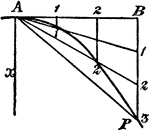
Construction Of A Parabola
An illustration showing how to construct a parabola. "Given the vertex A, axis x, and a point P. Draw…
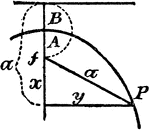
Construction Of A Parabola
An illustration showing how to construct a parabola. "Given the axis of ordinate B, and vertex A. Take…
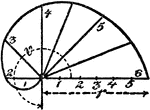
Construction Of An Arithmetic Spiral
An illustration showing how to construct an arithmetic spiral. "Given the pitch p and angle v, divide…

Circle Sector
An illustration showing a circle sector with radius r, center/central angle v, and length of circle…

Circle Sector
An illustration showing a circle sector with center/central angle v and polygon angle w.
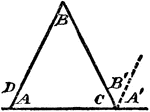
Exterior And Interior Angles Of A Triangle
An illustration showing a triangle with interior angles A, B, C, and exterior angles D, and A' + B'.

Model Of Geometric Relationships In A Circle
An illustration showing a model of a circle with an exterior angle formed between a tangent and a secant…

Model Of Geometric Relationships In A Circle
An illustration showing a model of a circle with angles formed between tangents and secants that illustrates…

Model Of Geometric Relationships In 2 Circles
An illustration showing a model of 2 circles with tangent lines, diameters, and radii that illustrates…

Model Of Geometric Relationships In 2 Circles
An illustration showing a model of 2 circles with tangent lines, diameters, and radii that illustrates…

Frontal Section Through Shoulder Joint
The frontal section through the right shoulder joint of a boy. Arm abducted to a right angle.

Horizontal Section Through Shoulder Joint
A horizontal section through the left shoulder joint of a boy. Arm abducted to a right angle.
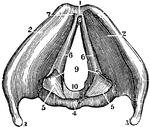
A View of the Larynx Showing the Vocal Ligaments
A view of the larynx showing the vocal ligaments. Labels: 1, The anterior edge of the larynx. 4, The…
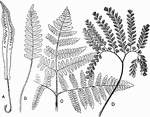
Fern Leaves
"Fern leaves, showing various degrees of subdivision or branching of the blade. A, Phyllitis; B, Polypodium;…

Sarcostyles from Wasp
Sarcostyles from the wing muscle of a wasp. A, A'. A sarcostyles showing degrees of retraction. B. A…
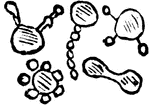
Effect of Heat on Red Blood Cells
The effect of heat on red blood cells up to 50-60 degrees C. (120-140 degrees F.) is to cause the formation…
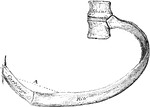
Movement of Ribs in Inspiration
The elevation of the ribs is accompanied by a slight opening out of the angle which the bony part forms…

Modern Decorative Easel
The modern decorative easel is a sloping frame with three or four legs. The front and rear are often…

Changes in the Thorax following Scoliosis of the Spine
Showing the changes in the thorax which follow scoliosis of the spine. The convexity of the spinal curvature…

Dip
"Dip, in geology, the name given to the angle of slope of inclined rock strata, as dip in the diagram...The…
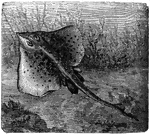
The White Ray (Raia Batis)
"The White Ray is in the form of a rhomb, the point of the muzzle forming the lower angle, the longest…

Trunk of the Meat-Fly
"The trunk appears to be composed of two parts, joined, and forming a more or less obtuse angle."
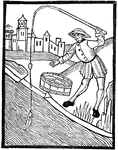
Fyshynge with an Angle
A print from the engraving, ""Fyshynge with an Angle" from 'The Book of St. Albans' printed by Wynkyn…
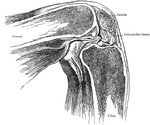
Position of Patella in Relation to Condyles of Femur with Knee Flexed
Showing position of patella in relation to condyles of femur with knee flexed at a right angle.
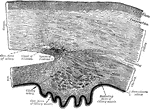
Section of the Eye
Section of the eye, showing the relations of the cornea, sclera, and iris, together with the Ciliary…
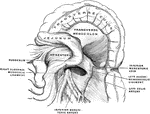
Duodenojejunal Fossa
The duodenojejunal fossa is formed where the duodenojejunal angle enters the root of the transverse…

Front of the Skull
Shown is norma frontalis, which refers to the front of the skull. Labels: 1, mental protuberance; 2,…
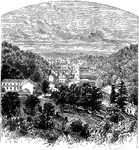
Hot Springs, Arkanasas
An view of Hot Springs, Arkansas which is nestled in a valley between two mountains. Hot Springs is…

Bishop Hugh Latimer
Hugh Latimer (c. 1485-October 16, 1555) was the bishop of Worcester, and by his death he became a famous…
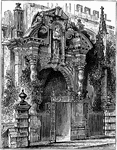
Porch of St. Mary's, Oxford
A church was established on this site, at the centre of the old walled city, in Anglo Saxon times. St…

Contour Lines
A contour about to cross a stream runs up one side and down the other, making a V where it crosses,…

Hay Knife
Some knives have the handle placed at a right angle with the blade. The farmer in cutting hay from the…

Draw Knife (Colonial Tool)
One very useful knife has a long blade with a cutting edge on one side, and a handle at each end, placed…

Core Box Plane
With the plane, one can make rough wood true, smooth and beautiful. The name plane, perhaps, comes from…

Brewery Diagram
A diagram of a brewery. A brewery is a dedicated building for the making of beer, though beer can be…

Tower Brewery Cellars
A diagram of a tower brewery cellars. A brewery is a dedicated building for the making of beer, though…
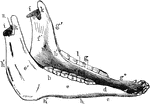
Inferior Maxilla of a Horse
Inferior maxilla of a horse-anterolateral view. Labels: a, body; b, b', rami; c, neck; d, mental foramen;…
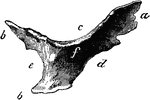
Cardiac Bone of an Ox
Right cardiac bone of an ox. Labels: a, anterior angle; b, posterior angles; c, superior border; d,…
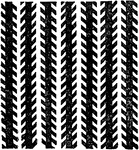
Zollner Illusion
The Zöllner illusion is a classic optical illusion named after its discoverer, German astrophysicist…

Bloody Angle of Spotsylvania
The angle between the Union II and VI Corps became known as the "Bloody Angle of Spotsylvania", where…
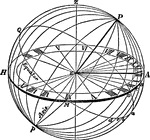
Horizontal Dial
The chief advantages of the horizontal sundial are that it is easy to read, and the sun lights the face…

Sundial
A sundial is a device that measures time by the position of the Sun. In common designs such as the horizontal…
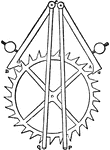
Mudge's Gravity Escapement
A gravity escapement uses a small weight or a weak spring to give an impulse directly to the pendulum.…

Bloxam's Gravity Escapement
A gravity escapement uses a small weight or a weak spring to give an impulse directly to the pendulum.…


